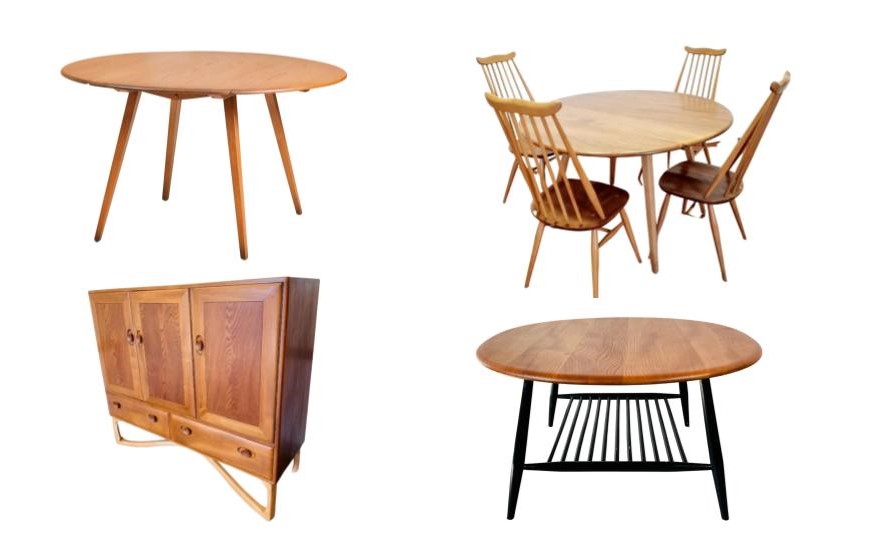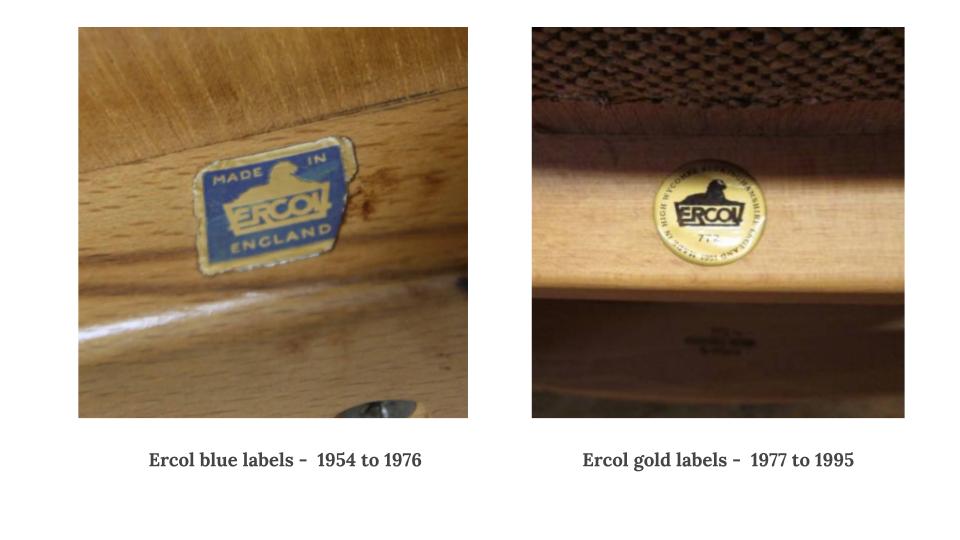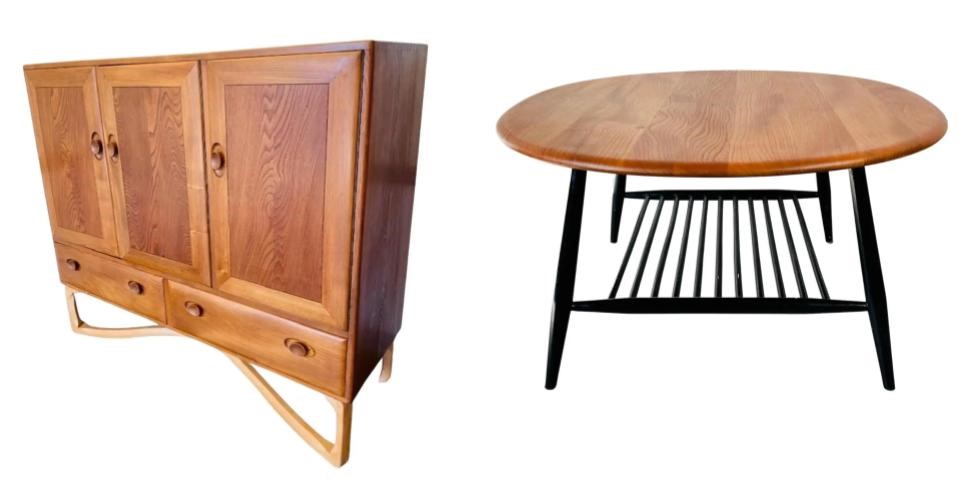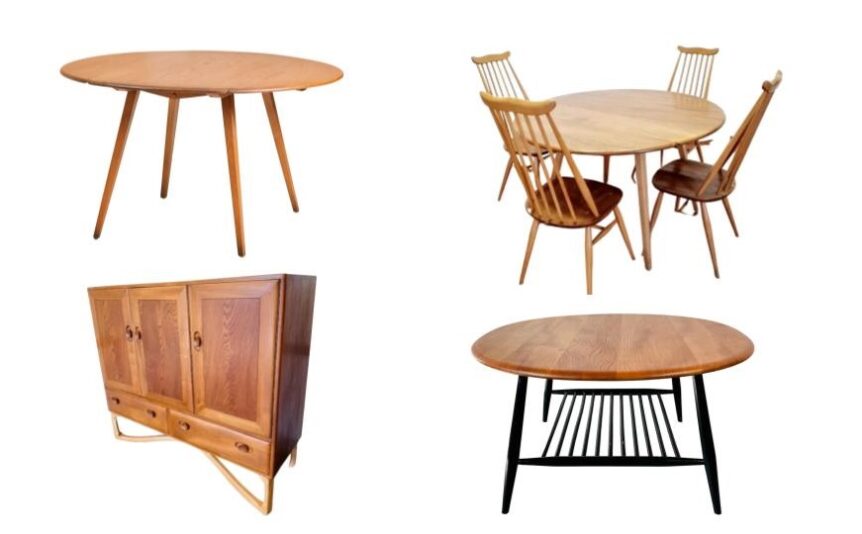Discover the hallmarks of authentic vintage Ercol – from maker’s marks and quality craftsmanship to quintessential mid-century design.

Mid-century modern furniture has been slowly growing in popularity over the last decade and is now one of the most sought-after styles for adding a touch of class to contemporary homes.
And you can see why – it was built to last by manufacturers who placed an emphasis on quality craftsmanship and was designed with both aesthetics and functionality in mind.
However, because of the popularity of mid-century furniture, contemporary manufacturers are making new items in this style, making it harder to identify authentic mid-century pieces.
So how can you tell if a piece of furniture is an authentic Ercol?
There are a few things you can do to identify original Ercol furniture which includes, looking for a manufacturer’s stamp, considering its functionality, and looking for design features such as minimal clean lines. Other ways to recognize Ercol pieces include finding out the type of wood it was made from and the construction techniques used.
I will go into more detail on how to examine these elements to determine if a piece is in fact an original Ercol furniture piece and not a modern replica.
Ercol History and Timeline
To understand how to identify authentic vintage Ercol, it helps to first look at a brief history of the company:
– Founded in 1920 in High Wycombe, Buckinghamshire by Italian immigrant Lucian Ercolani. He opened the workshop on Tottenham Road.
– Specialized in bentwood chair manufacturing in the 1920s using the steam-bending technique to produce the iconic Ercol Windsor and Cromwell chairs.
– Expanded into cabinetmaking in the 1930s and secured a London showroom on Wigmore Street to unveil their debut furniture collection.
– Halted production in WW2 when the factory was used to manufacture parts for the war effort like Mosquito airplane cockpits.
– Saw huge success in the post-war period selling quality mid-century wooden furnishings for British homes.
– Released some of their most recognizable designs in the 1950s and 1960s like the Studio Couch, Butterfly Table, Standard Lamp and Rocking Chair.
– Began exporting worldwide and opened new factories in Princes Risborough and Holland.
– Started facing more competition from cheaper imports in the 1970s but maintained the emphasis on hand craftsmanship.
– Still manufacturing furniture today with a blending of classic and contemporary design.
So when identifying Ercol, the key periods to look for are furniture pieces from the 1940-1970s, considered the vintage era when they produced iconic mid-century modernist designs.
How to recognize Ercol furniture
1.Look for the Ercol Stamp
An effective starting point when trying to verify if a furniture piece is a genuine vintage Ercol is to carefully examine it for any kind of identifying marker or stamp.
Earlier examples produced up until the late 1950s should have an oval paper label on the underside or back that clearly displays the full company name “Ercol Furniture Ltd”. This is a strong indication of authenticity.
From the 1960s onwards, you are more likely to find an indented stamp impression displaying just the name “Ercol” along with a date code. For instance, “Ercol 66” would denote a piece manufactured in 1966. This helps date and confirm Ercol’s origins.
In some cases, additional stamps may also indicate the specific furniture model like “Windsor” or “Studio Couch”. However, these model names were not consistently applied.
It’s worth thoroughly checking all surfaces as stamp locations can vary. And don’t rule it out as Ercol if no markings are found, as many pieces left the factory without identification. But an authentic stamp is a very positive sign of vintage origins.

2. Consider the Practicality and Purpose

In addition to checking for markings, you can identify an original Ercol by carefully considering the intended functionality and purpose of the furniture piece.
Lucian Ercolani prioritized sensible design and believed furniture should work efficiently within the home while also being pleasing to the eye.
For example, Ercol coffee and side tables were created to be at a useful height while looking elegant and streamlined. Storage units like cabinets and bookcases were designed to be compact and make smart use of space.
Iconic models like the butterfly dining table could fold up when not entertaining. And their triangular stacking tables slotted together stylishly when not in use.
These clever innovations meant Ercol furniture adapted well to smaller post-war British homes in the 1950s and 60s.
So if a piece seems thoughtfully designed with purpose and everyday practical living in mind, it’s likely to be vintage Ercol. The functionality and versatility are clues to its origins.
Related articles:
- How To Identify Nathan Furniture
- How To Identify Mcintosh Of Kirkcaldy Furniture
- 10 Best Vintage Danish Furniture Brands of the 1960s and 1970s
3. Inspect the Mid-Century Design Attributes
Ercol is renowned for its clean, minimalist lines and elegant simplicity as part of the mid-century modern furniture movement.
When trying to verify that a furniture item is a genuine vintage Ercol design, look closely for this telltale mid-century and Ercol attributes:
– Gracefully tapered legs, either splayed or straight. Made from solid beech or oak. The iconic “ribbon back” range had splayed tapered legs.
– Spindle back dining chairs with the signature gently curved wooden slats resembling a ladder.
– Smoothly contoured edges to cabinets, shelves, chair arms, and tables.
– Little ornamentation apart from occasional stamps and labels. Simple brass detailing on pulls and hinges.
– Natural wood tones like raw oak, teak, and walnut. Later pieces experimented with color washes.
– Woven seat pads made from materials like linen, leather and crisscross cord.
– Organic shapes like the sensuous curves on the Studio Couch and Butterfly Table.
– Finished with hand-rubbed lacquer for warmth and touch appeal.
Focus on the legs, joinery, shaping, and silhouettes when comparing furniture elements against Ercol’s original mid-century ranges. The pared-back designs should align.
Related articles:
- What Wood is Used for Mid-Century Modern Furniture?
- How to Identify G-Plan Furniture
- 15 Best Mid-Century Sideboards (1960s-1970s)
4. Analyze the Wood Types and Construction
The types of wood used and the methods of construction are other key indicators when determining if a furniture piece is a genuine vintage Ercol.
The company favored solid elm, beech and oak wood for crafting their mid-century cabinetry, tables, seating and storage units. So being able to identify these high-quality hardwoods is an important skill.
Elm has a distinct coarse, interlocked grain pattern. Beech is coveted for its silky smooth finish. And oak displays wavy wood grain with unique markings.
Run your hands over the furniture and get a feel for the wood species based on the grain texture and markings. This will come with practice as you encounter more examples.
Also, assess how the edges have been finished. Original Ercols almost always have smoothly rounded and contoured edges rather than sharp, machine-cut lines. The shaping of the solid wood is a sign of fine hand craftsmanship.
And inspect any joinery like dovetail drawer joints and precisely angled wood connections. Proper joinery confirms traditional cabinetry skills.
The combination of premium solid woods and meticulous hand finishing provides clues that a furniture piece is a genuine vintage Ercol original.

Related articles:
Related Questions
How can you tell how old Ercol furniture is?
The easiest way to identify the age of an Ercol furniture piece is to look for a manufacturer’s stamp on the underside or back. Earlier labels will have the full name “Ercol Furniture Ltd” while stamps from the 1960s onward will typically just say “Ercol” along with a date code.
For example, “Ercol 66” would mean the item was made in 1966. Knowing the era it was produced can help determine the range and collection. You can also analyze the style and design features to get a sense of whether it’s early mid-century or later 20th-century.
Key traits like spindle backs, splayed legs, and woven seat pads can help date it. Construction methods and wood type are also clues. But finding a clear stamp or label is the most reliable technique.
Why is Ercol furniture so expensive?
There are a few reasons why original vintage Ercol furniture commands high prices. Firstly, it is well-made from quality solid woods like oak, elm and beech using proven construction methods like dovetail joints. This means vintage Ercols have stood the test of time.
Secondly, Ercol’s mid-century designs are very collectible because they have a clean, timeless aesthetic that’s currently in vogue. The company made some very iconic pieces in the 1950s/60s like the Windsor chair.
Thirdly, as an early pioneer of mid-century modern furniture, the Ercol name carries prestige. Combined with the limited supply of genuine vintage furniture, these factors make authentic Ercol very desirable and valuable on the collectors market.
What kind of wood is Ercol furniture made of?
Ercol predominantly utilized elm, oak, and beech wood for constructing their mid-century furniture ranges. Elm features distinctive coarse interlocking grain patterns. Oak has a familiar wavy grain. And beech is coveted for its smooth, satiny finish once worked.
Solid woods were used to create quality functional frames. Ercol also pioneered techniques like steam bending to shape signature curved components like chair backs. Woods were kept light and natural in color to showcase the beautiful natural patterns and grains. So when examining Ercol furnishing, look for elm, oak, or beech as telltale signs of authenticity.
Key Takeaways
When trying to identify original vintage Ercol furniture, the first step is to look for any labels, stamps, or markings on the underside or back.
But if no identification is found, you can rely on other tactics like assessing the design qualities, functionality, wood choices, and construction methods against Ercol’s popular mid-century ranges.
Details like elegant tapered legs, signature woven seat pads, and the use of quality woods like elm and oak indicate authentic Ercol origins.
While not all Ercol pieces are marked, with some detective work and attention to detail you can confidently recognize the superb craftsmanship and lasting appeal of these British mid-century classics.
I hope this guide helps you identify and appreciate the exceptional furnishings that made Ercol one of the era’s finest furniture makers. Their designs perfectly capture the understated beauty of mid-century modern style.


